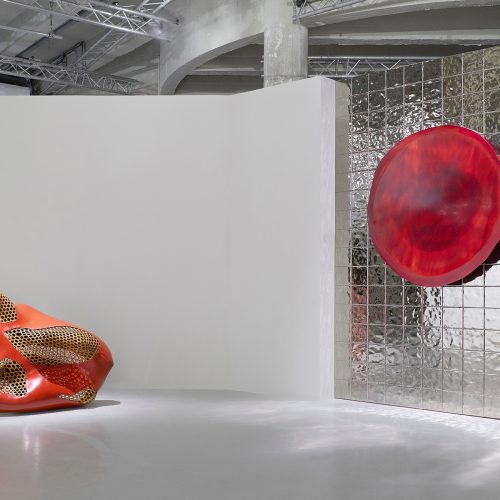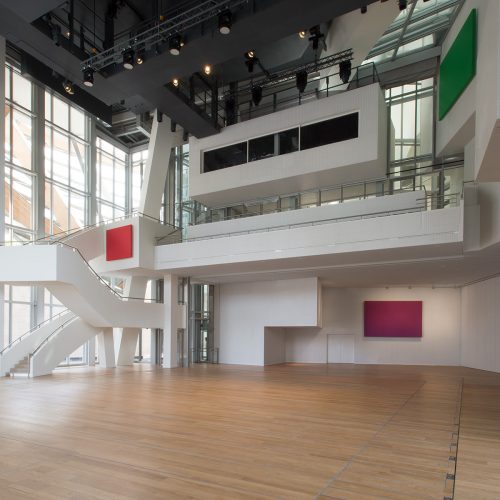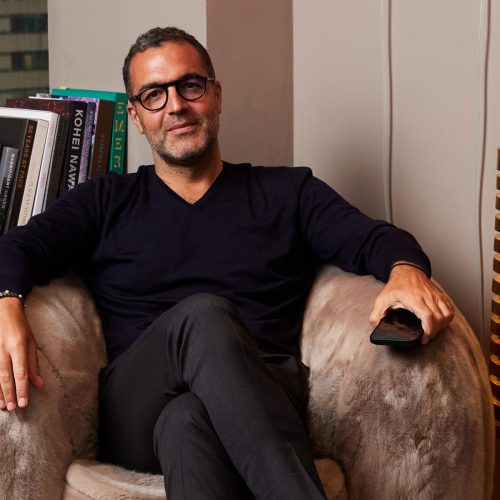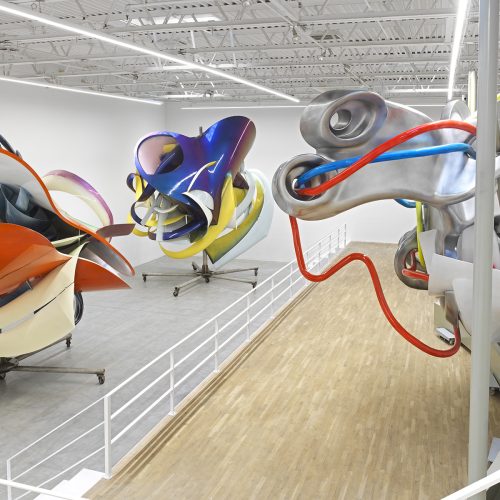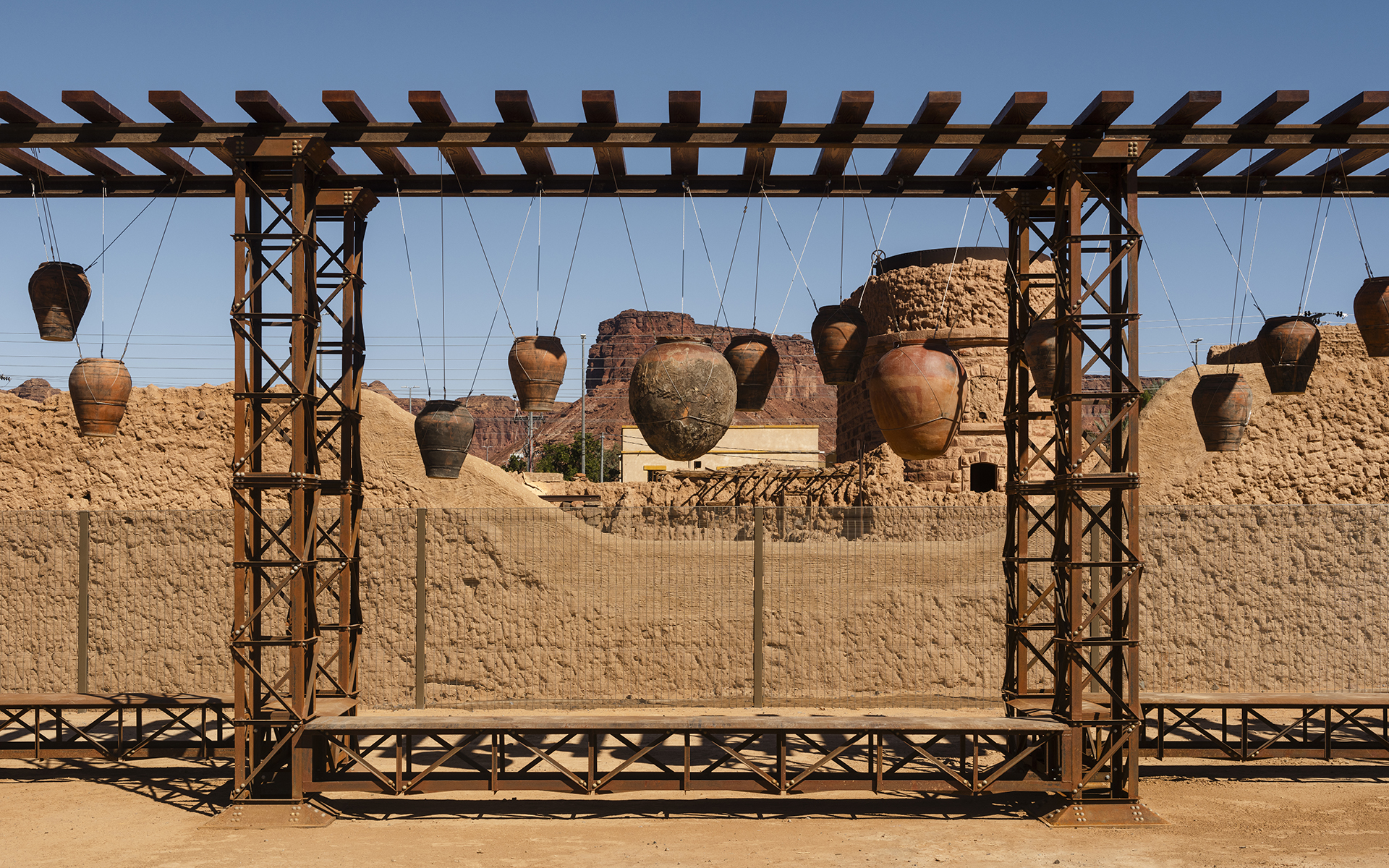

Discover the Most Powerful Large-Scale Installations at this Year’s Desert X AlUla
The third edition of the international art exhibition shines a light on the otherworldly desert landscape of the Saudi Arabian region
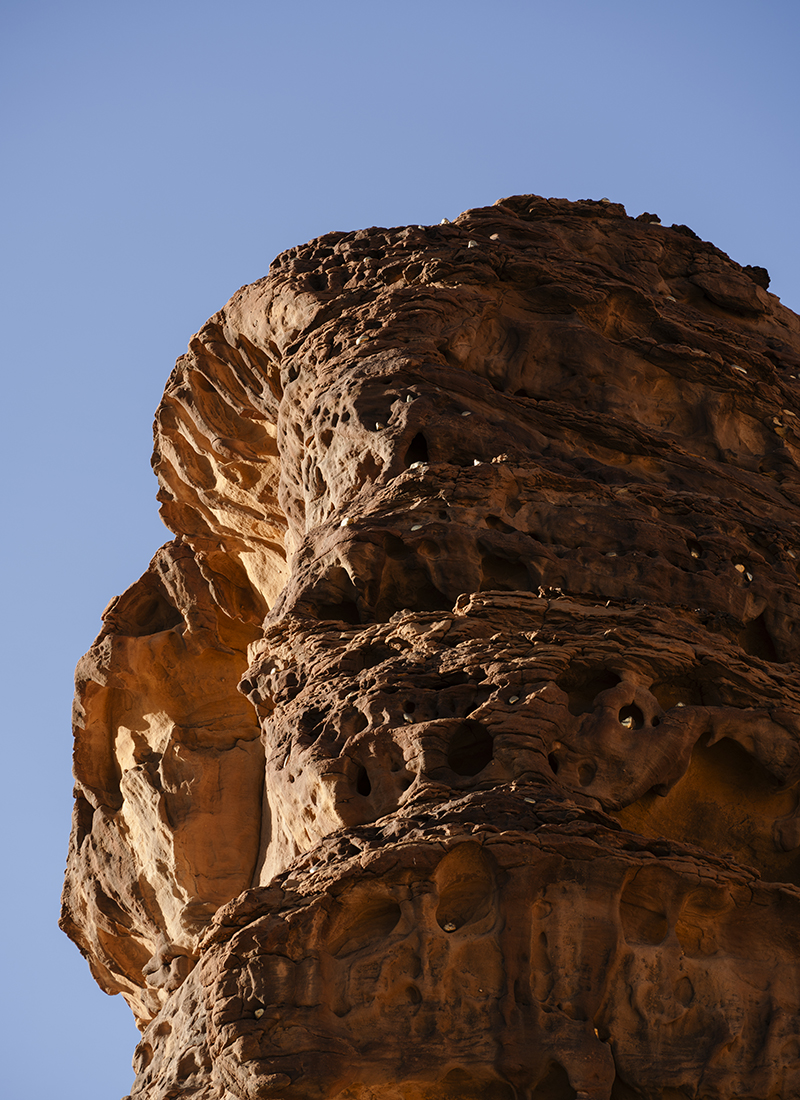
Bosco Sodi, When I saw my reflection, Desert X AlUla 2024. Photo: Lance Gerber; courtesy of The Royal Commission for AlUla
As the sun begins to set over the mystical rock formations of AlUla, Saudi Arabia’s ancient desert landscape, a group visitors walk down inside a long triangular shaped excavation in the desert sands—the work of Saudi duo Sara Alissa and Nojoud Alsudairi’s Invisible Possibilities: When the Earth Began to Look at Itself. The spectators make their way through the work as if in a procession, walking serenely down the carefully carved desert sand steps until they enter the cavity below and for a split second, they become one with the surrounding landscape—the tops of their heads the same level as that of the earth. Created for the third edition of Desert X AlUla, the work, states the artists, aims to reformulate viewers’ perception of AlUla’s ecological transition and its physical geographies. It also, like the theme of this year’s Desert X AlUla “In the Absence of Presence,” celebrates aspects of the desert landscape that are often overlooked or unseen.
“AlUla is sublime,” said Saudi artist Filwa Nazer. “It is at once beautiful and overpowering.”

Sara Alissa and Nojoud Alsudairi, Invisible Possibilities, When the Earth Begins to Look at Itself, Desert X AlUla 2024. Photo: Lance Gerber; courtesy of The Royal Commission for AlUla
Nazer’s work, Preserving Shadows, takes the form of an elevated walkway made from steel mesh to create a larger-than-life, undulating black snake set amid the desert sands and against AlUla’s poignant rock formations. “My work reflects the idea of fear and hostility in relation to the nature of the desert and in return the connection between nature and the supernatural,” explained Nazer.
Inspired by pre-Islamic beliefs of jinn or evil spirits that were once believed to inhabit the desert landscape, Nazer’s powerful work is about overcoming one’s fears in relation to the desert. “Growing up in the previous Saudi Arabia, we heard many stories about jinn in this part of the country,” recounts Nazer. “I come from Jeddah, a city on the Red Sea.
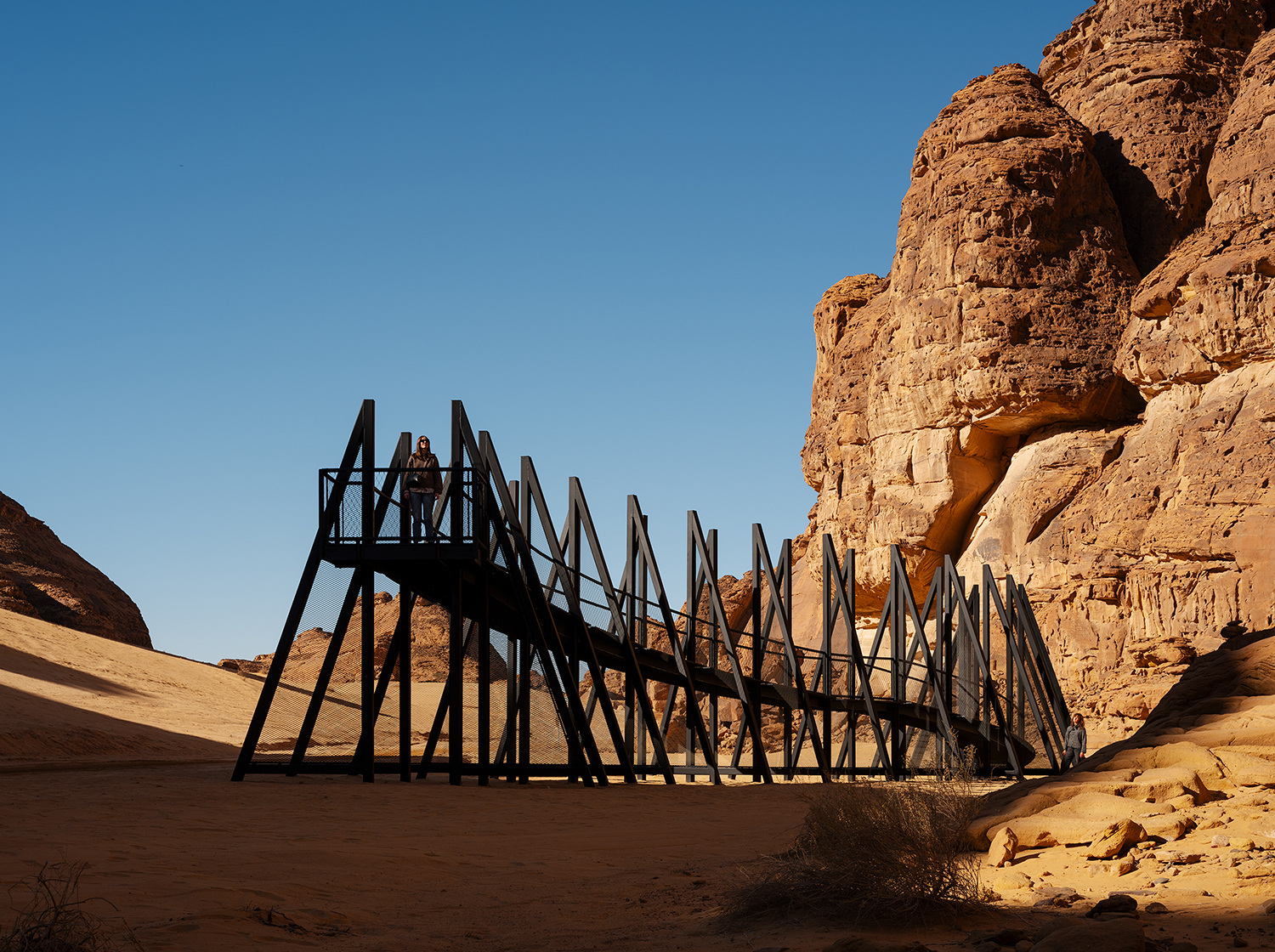
Filwa Nazer, Preserving Shadows, Desert X AlUla 2024. Photo: Lance Gerber; courtesy of The Royal Commission for AlUla
The stories I heard about jinn amplified the fear of not knowing or understanding the desert.” Connecting to the desert landscape of AlUla was challenging at first states Nazer. While she was doing research for the work, she read a story of two men sitting in the desert around a fire that were suddenly attacked and killed by snakes that came out from the shrubs.
“The work is inspired by the body of a petrified skeleton of a snake, and it is meant to feel as if you are walking through a journey of shadows—a metaphor for overcoming a dark and fearful journey,” she says.

Kimsooja, To Breathe – AlUla, Desert X AlUla 2024. Photo: Lance Gerber; courtesy of The Royal Commission for AlUla
In a similar fashion to the work of Alissa and Alsudairi, Nazer’s work prompts visitors to walk across the work that acts like a bridge in a metaphorical act of emotional and physical transformation.
Following two exhibitions since 2020, the third edition of Desert X AlUla, the highlight of the AlUla Arts Festival, part of the AlUla Moments calendar of events, which runs from February 9—March 23, probes the question: What cannot be seen? In relation to the vast, largely viewed as empty, static and lifeless desert landscape.

Rana Haddad and Pascal Hachem, Reveries, Desert X AlUla 2024. Photo: Lance Gerber; courtesy of The Royal Commission for AlUla
This year’s exhibition was staged under the curatorial vision of Maya El Khalil and Marcello Dantas, with artistic direction from Raneem Farsi and Neville Wakefield.
“The first time I came to AlUla, I camped out in the desert,” said El Khalil who first visited AlUla in 1995. “It was a period when very few people would visit the region. I remember seeing the most spectacular sunrise. For me, curating Desert X is about to how address the monumentality of AlUla through art. It is about learning from the landscape, its history and the invisible traces that are not often seen.”
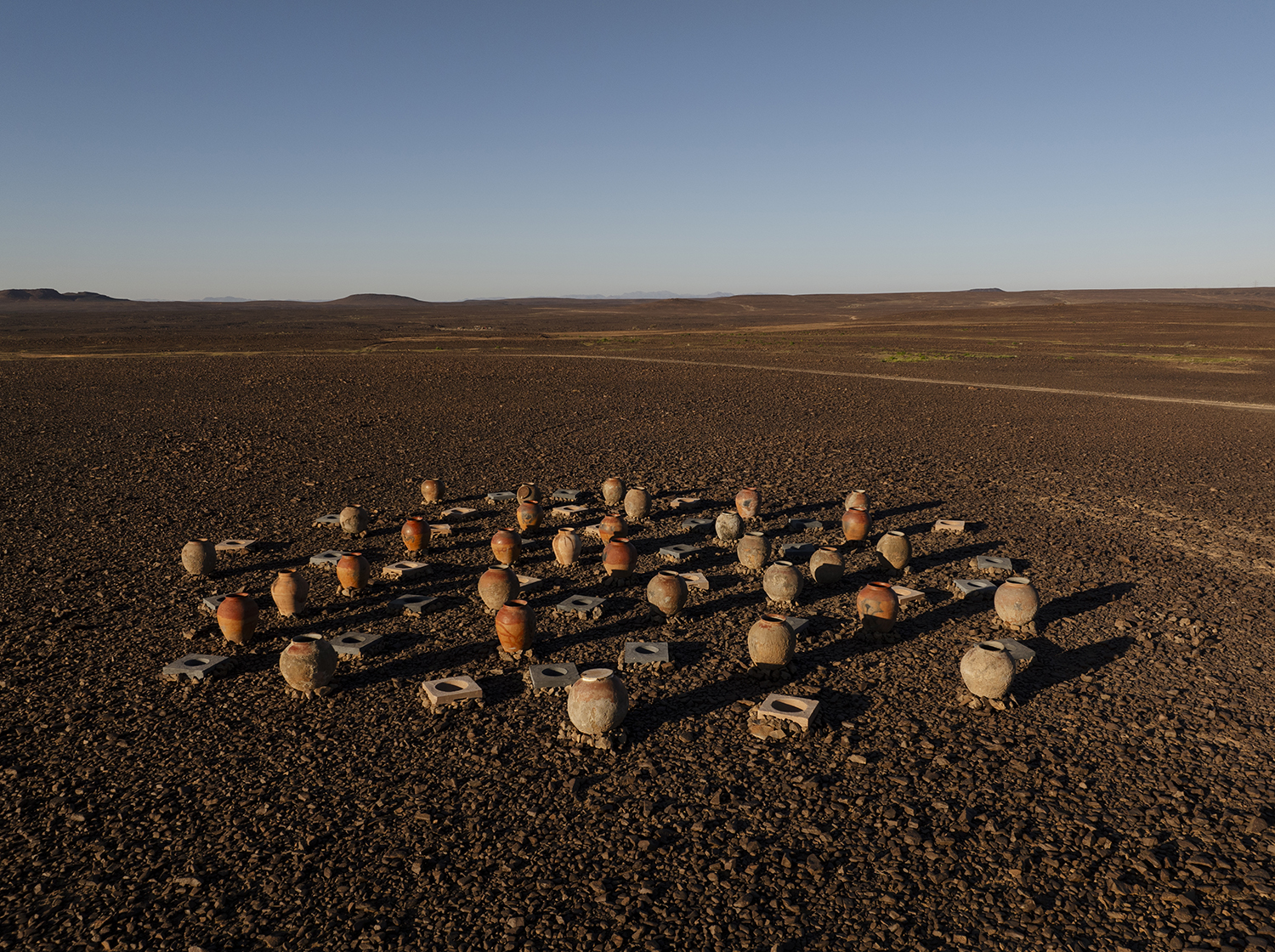
Ibrahim Mahama, Gabli Din Pali – A Full Gourd Does Not Rattle; It Is Only a Partially Filled Gourd Which Rattles, Desert X AlUla 2024. Photo: Lance Gerber; courtesy of The Royal Commission for AlUla
The works on view by 17 artists from Saudi, across the Middle East and internationally, testify how the desert landscape, with its daunting character and sublime beauty, holds more stories, more life, than often meets the eye.
Like in previous editions, participating artists were invited to visit AlUla as they were creating their commissions. Exhibited artists include Ibrahim Mahama, Giuseppe Penone, Moniri Al Qadiri, Karola Braga, Kader Attia, Rand Abdul Jabbar, Kimsooja and Bosco Sodi.
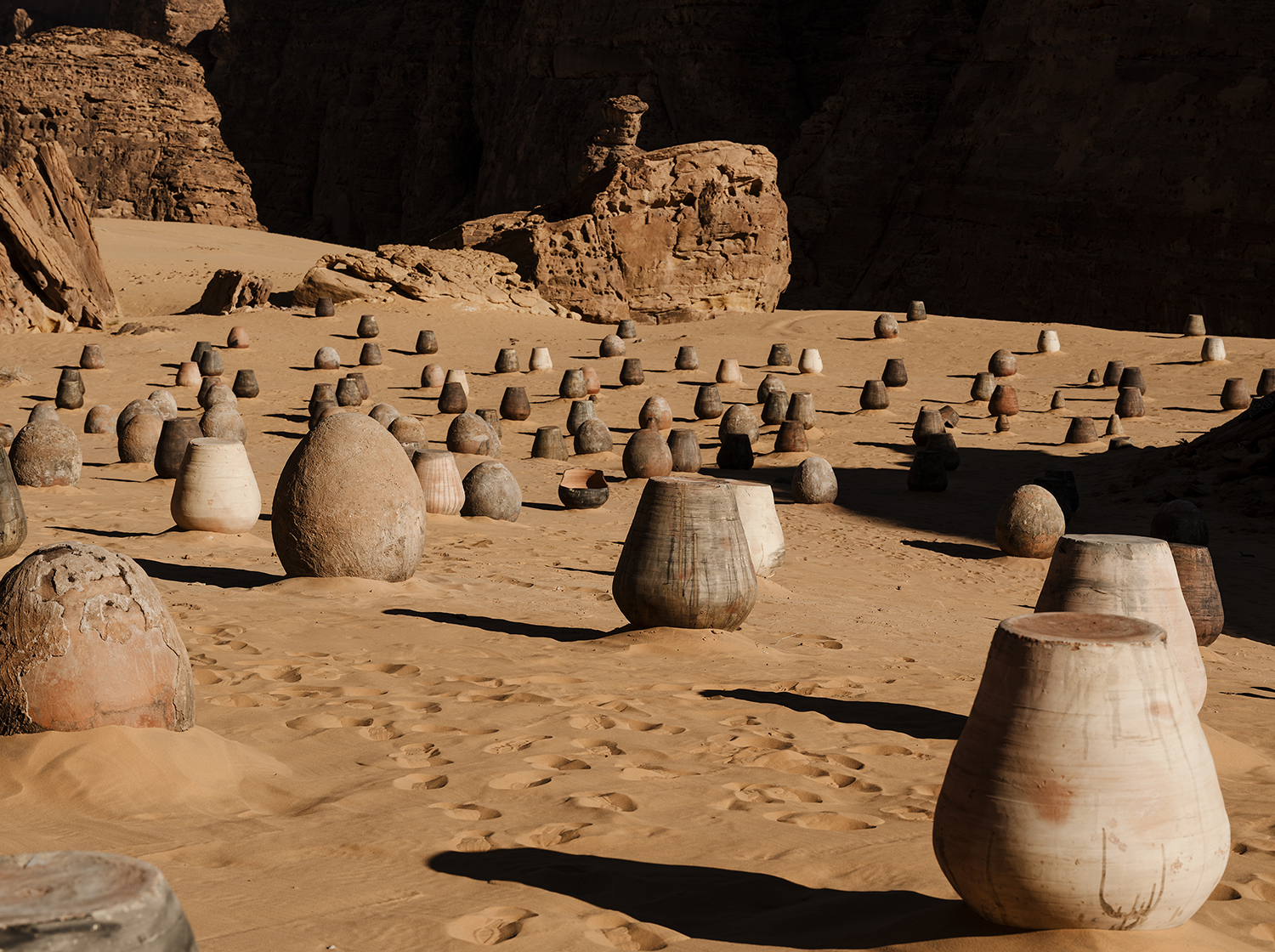
Ibrahim Mahama, Dung Bara – The Rider Does Not Know the Ground Is Hot, Desert X AlUla 2024. Photo: Lance Gerber; courtesy of The Royal Commission for AlUla
The exhibition is situated across three locations for the first time: Wadi AlFann or Valley of the Arts, where artworks were positioned amid the black lava stone terrain, breathtaking views atop the rocky Harrat Uwayrid and at the AlManshiyah Plaza, which features a work of terracotta pots titled “Hanging Garden” by Ibrahim Mahama amid the carefully preserved Hijaz Railway Station, which began its construction around 1900, reaching Madinah in 1908 and opening in Damascus in 1913. Mahama’s hung pots suggest how new narratives and ecosystems can emerge from the relics of history—an apt remark due to the railway’s unfinished state yet historical importance. Due to World War I, the railway was not completed. Mahama’s terracotta pots can also be found in the two other locations of Desert X titled “Dung Bara – The Rider Does Not Know the the Ground is Hot” in Wadi AlFann and “Gabli Din Pali – A Full Gourd Does Not Rattle; It Is Only a Partially Filled Gourd Which Rattles” on Harrat Uwayrid.
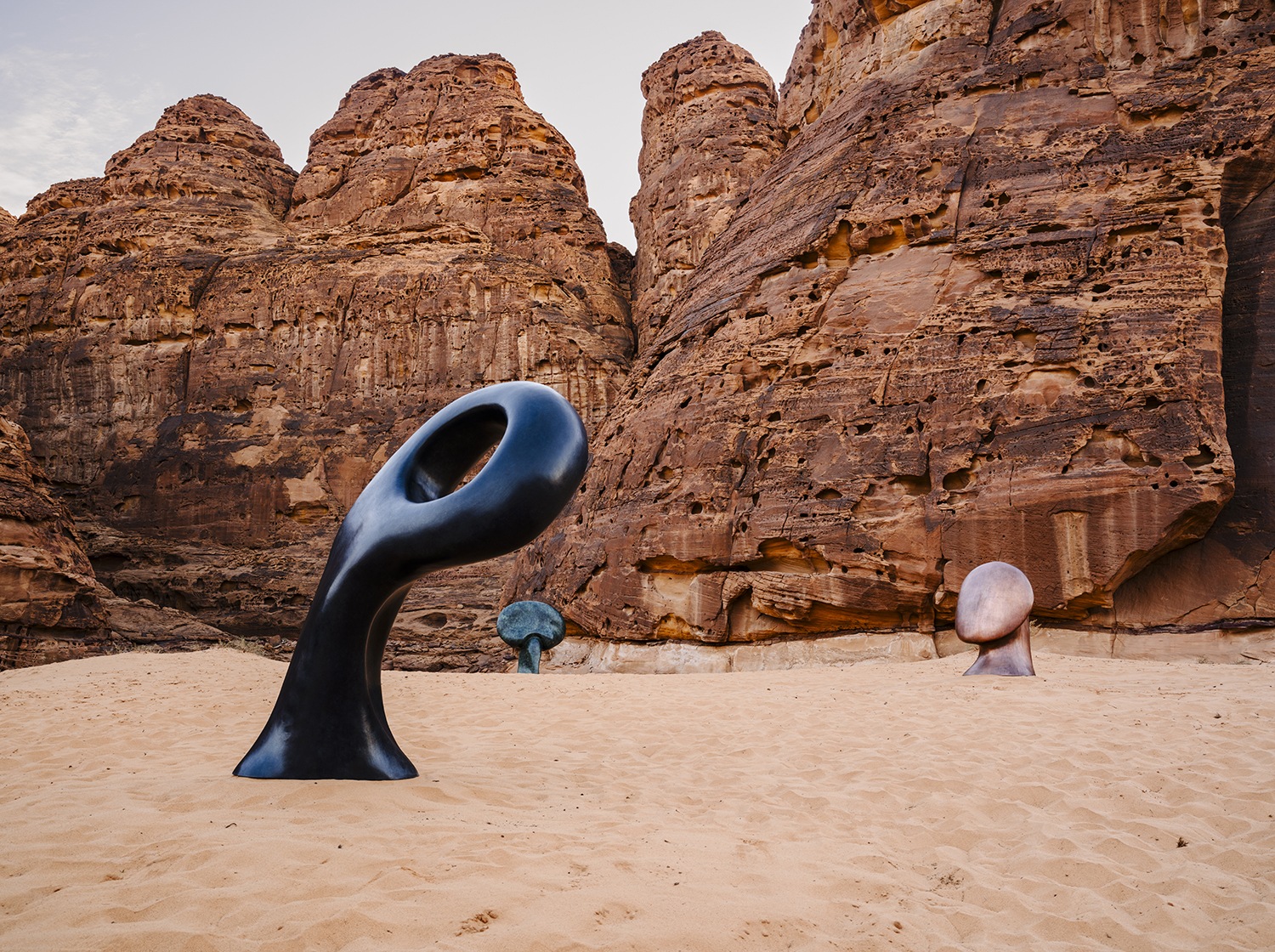
Rand Abdul Jabbar, Where myths are born of mud and desire, Desert X AlUla 2024. Photo: Lance Gerber; courtesy of The Royal Commission for AlUla
Other highlights include Rand Abdul Jabbar’s “Where Myths are Born of Mud and Desire,” located in an alcove in the mountain valley encompassing five sculptural forms telling the story of Venus. The works play beautifully with the sunlight reflective on their anamorphous forms that change shades according to the time of day.
Titled “The Dot”, Faisal Samra’s work takes the shape of a giant circular mirrored sphere with a line of carefully placed rocks that lead to its location. The piece shows how the Wadi AlFann valley originated from an ancient crack, demonstrating how a small invisible movement shaped the majestic and grand character of the region over millenia.
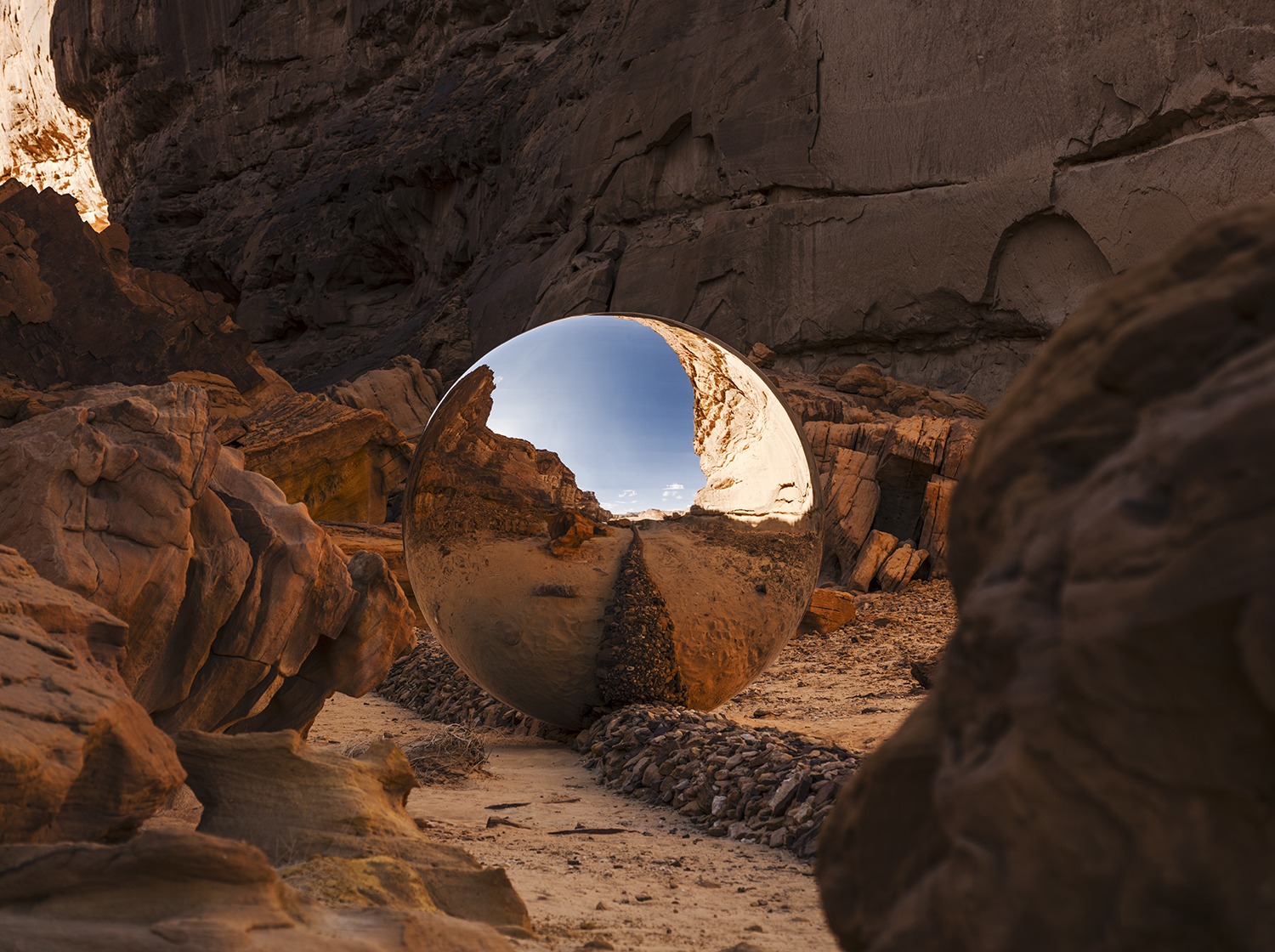
Faisal Samra, The Dot, Desert X AlUla 2024. Photo: Lance Gerber; courtesy of The Royal Commission for AlUla
The works in this edition of Desert X collaborate almost seamlessly with the surrounding landscape. Rather than stand independently from the millions of years old rock formations, they complement the desert through artistic creations of both vulnerability, strength and determination. Many of these works would change their artistic dialogue if removed from the AlUla landscape—itself a testament to the strength of the art and the curation of this year’s edition.
“It was about encouraging artists to encounter the landscape from a largely non-human centric approach, if that can be possible,” added El Khalil, emphasizing how artists strove to think beyond human perception to create artwork for the desert landscape. “At the end of day, we are humans encountering that landscape, but we can also add different perspectives to the way we view it and take into consideration, the history of the invisible aspects of the desert, the flora and fauna and what lies beneath the manifestation of the elements.”

Giuseppe Penone, The Logic of the Vegetal – Metamorphosis, Desert X AlUla 2024. Photo: Lance Gerber; courtesy of The Royal Commission for AlUla
An example of intricate and exacting dialogue of the artworks with the surrounding environment is Giuseppe Penone’s “The Logic of the Vegetal –Metamorphosis.” When at first viewed, spectators might be surprised that the work is in fact an artwork. The fossilized tree trunk, which hovers between living organism and mineral state, reflects the cyclical nature of life. It seems as if it were always there, an artwork that is nature-made instead of man-made. Penone’s work, intimate in nature and so sensitive to the environment in which it is place, ponders the unseen transformations that occur over time.
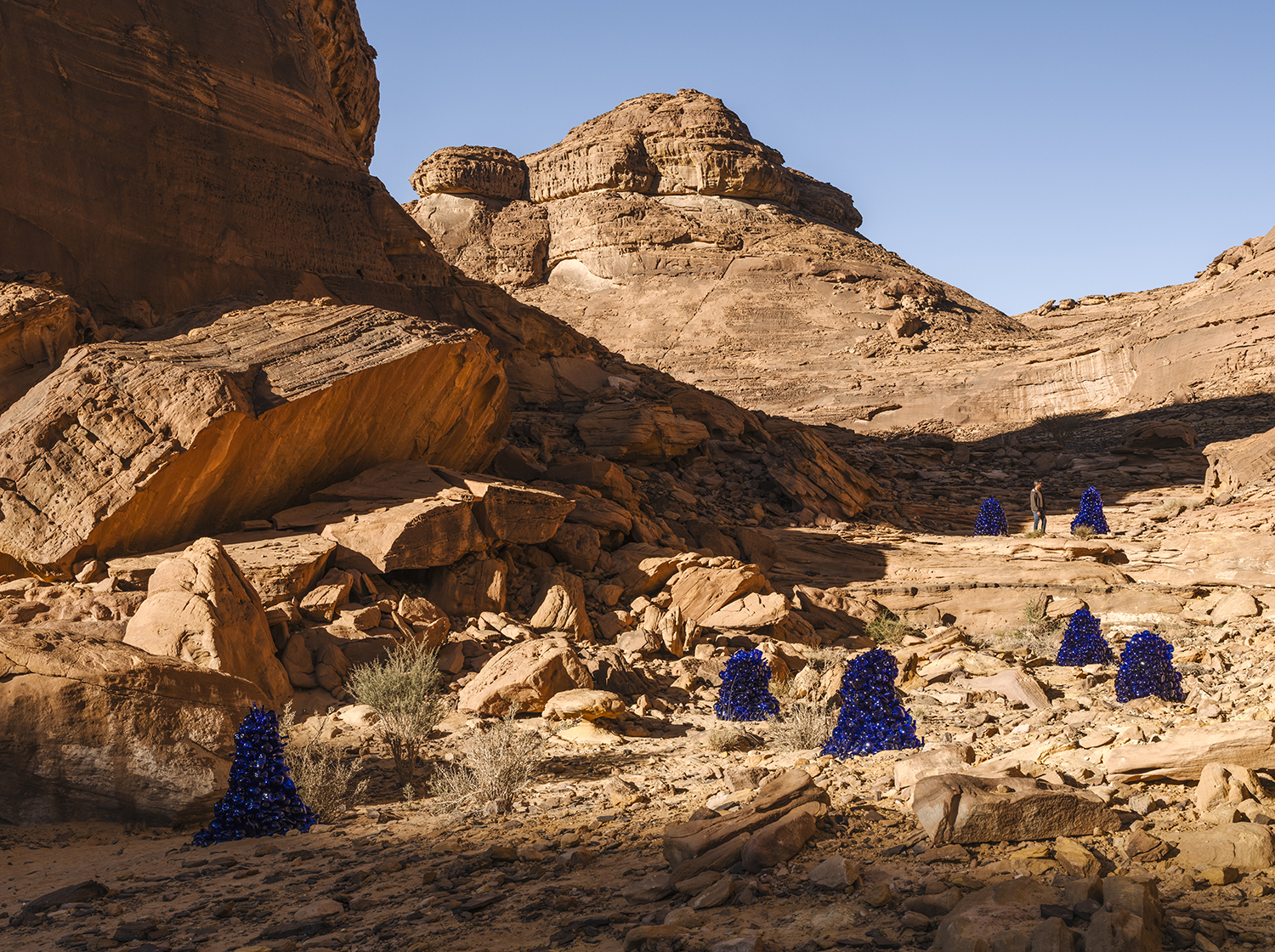
Kader Attia, Whistleblower, Desert X AlUla 2024. Photo: Lance Gerber; courtesy of The Royal Commission for AlUla
Positioned up the rocky crevices of a rock formation are the vibrant blue necks of glass bottles that emerge from Kader Attia’s sculptures in “Whistleblower.” They glisten as if they were jewels that had dropped from outer space into a strange and beautiful land. And they also whistle when they are open to the wind. They, like the other works on show, invite nature to participate in art just as the alluring natural landscape of AlUla has seemingly opened its arms for the creations of human dwellers—creations that will themselves leave more invisible, transformative marks for thousands of years to come.
Desert X AlUla 2024 runs from February 9 – March 23

